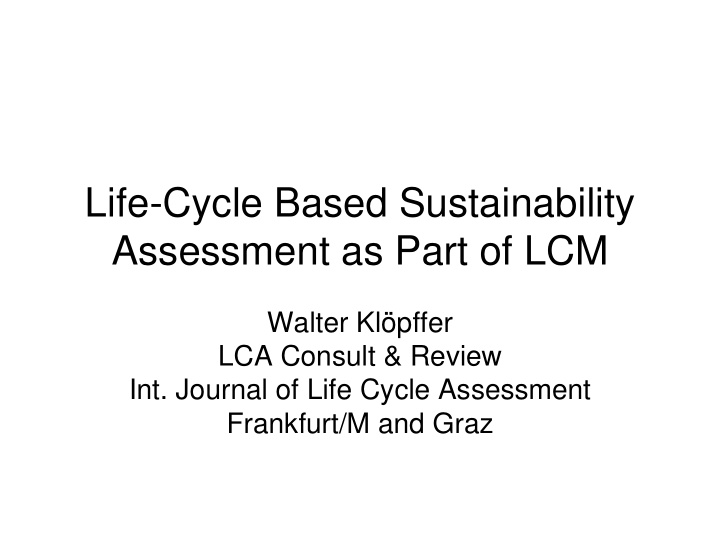



Life-Cycle Based Sustainability Assessment as Part of LCM Walter Klöpffer LCA Consult & Review Int. Journal of Life Cycle Assessment Frankfurt/M and Graz
LCA • LCA = Environmental Life Cycle Assessment • Full sustainability assessment needs at least two further dimensions • 1st SETAC Europe LCA Symposium, Leiden, December 1991
Hans-Carl von Carlowitz (1713)
Brundtland Report • Brundtland, G.: Our Common Future. Oxford University Press. Oxford 1987: • "Sustainable development is development that meets the needs of present without compromising the ability of future generations to meet their own needs"
United Nations • United Nations Conference of Environment and Development (UNCED) in Rio de Janeiro, 1992 • Sustainability identified as the guiding principle for the 21th Century • Reconfirmed in Johannesburg, 2002
Sustainability Assessment of Products , Quantification SustAss = LCA + LCC + SLCA • LCA: Environmental Life Cycle Assessment • LCC: LCA-type Life Cycle Costing • SLCA: Societal Life Cycle Assessment
Prerequisites • Equal and consistent system boundaries for the three life-cycle methods, including • Physical instead of marketing life cycle in LCC (“cradle-to-grave”) • Identical or at least compatible LCIs (SLCA will be more demanding with regard to regional resolution)
Why Life-cycle based? • Systems approach needed in order to: • Recognize and avoid trade-offs • No shifting of problems into the future!* • Life cycle thinking is a good starting point, but not enough for LC-based decisions • Quantitative methods are needed • Global system boundaries * especially important for sustainability, aspect of inter- generation fairness!
Status of LCA • Standardized method: • SETAC “Code of conduct” 1993, based on the Sesimbra workshop • ISO 14040-14043 (1997-2000) • ISO 14040+14044 (October 2006) superseded 14040-14043 • Research and testing needed for difficult impact categories and indicators, I/O, regionalization, consequential LCA etc.
Status of LCC • SETAC Europe working group 2003-2005 • Book to be published at CRC Press soon • SETAC Europe LCC Guideline writing group started May 2006: • To be finished for final discussion at the next SETAC World Congress August 3-7, 2008 in Sidney • Publication by SETAC in a global publishing house, e.g. Springer
Status of SLCA • Although the idea is not new (Ökoinstitut 1987, O`Brian et al. 1996), a steep increase in relevant papers occurred only recently: • Presentations at the SETAC World Congress, Portland 2004 • Dreyer et al. 2005; Weidema 2005, 2006; Norris 2006; Labuschagne and Brent 2006; Hunkeler 2006
SLCA Publications • Saling et al. 2007; Öko-Institut (PROSA) 2007(?); University of Stuttgart 2007 (?); Grießhammer et al. (UNEP-SETAC task force) 2006 • Jørgensen et al. 2007 (Review about methodologies for SLCA) • Still much grey literature, no consensus how the SLCA of the future will look like
Main Problems • How to relate quantitatively the existing indicators to the functional unit of the system • How to get enough specific data for the (necessarely) regionalized SLCA • Decision between many indicators (most of them qualitative) or few ones that can be quantified, e.g. via the LCI work-hours per functional unit (Hunkeler 2006)
One Assessment or three? Option 1: • SustAss = LCA + LCC + SLCA Main advantages: transparency, no weighing, no meaningless “sustainability points” Clear attribution of advantages and disadvantages in comparative product assessments, no compensation (very important!)
One Assessment or three? Option 2: • SustAss = “LCA new” (including LCC and SLCA as additional impact categories in Life Cycle Impact Assessment - LCIA). Advantage: only one LCI Question : • is Option 2 compatible with ISO 14040 + 14044?
ISO 14040 (2006) • “LCA addresses the environmental aspects and potential impacts ...throughout a product´s life cycle from raw material acquisition through production, use, end-of-life treatment, recycling and final disposal (i.e. cradle-to-grave)”. • “LCA typically does not address the economic or social aspects of a product, but the life cycle approach and methodologies described in this International Standard may be applied to these other aspects.”
Conclusions • SLCA is a necessary component of sustainability and thus LCM • SLCA of product systems is feasible • Several methods have been proposed (similar to the proto-LCAs in the 1980s) • More experience is needed (comparative studies) • Final aim: SETAC guideline and/or standardization by ISO
Recommend
More recommend